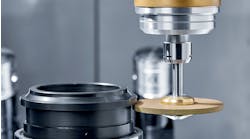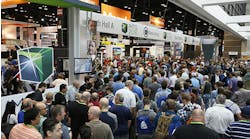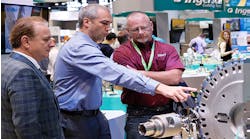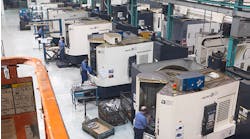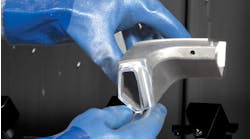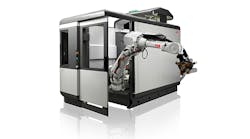Magerle’s new grinding center is the first large-scale five-axis design with equipped with a dual double-gripper for fast and flexible tool changing
United Grinding North America grabbed the early headlines on the first day of IMTS 2014 with its unveiling of the Mägerle MFP 100, a high-precision grinding machine targeted at the emerging demand for precision tools for large-scale systems, like drilling machinery, aircraft, or industrial engines, or even machine-tool spindles.
Mägerle is one of the United Grinding family of machines, grinding centers developed for large-batch operations, or that require high material removal volumes, as well as extremely high precision tolerances.
Mägerle designed the powerful, continuous dressing (CD) grinding and machining center with 50 kWs of spindle power for economical, complete machining of large, complex parts — where possible, in a single set-up. The machine is especially well suited, among other things, for machining turbine guide and rotor blades and heat shields.
In addition to its compact design and high output capabilities, it is distinguished by its fast and flexible tool changer and dual gripper system. The standard changer version can hold a total of 30 different tools – e.g., 15 grinding wheels and 15 diamond contour rolls, which are required for continuous dressing during the grinding process.
The maximum grinding wheel diameter is 300 mm; the maximum dressing roll diameter is 160 mm.
Furthermore, any other tool (… a drill, milling cutter, CBN wheel or measuring probe) can be automatically loaded/unloaded via the tool changer unit. Because the novel gripper always simultaneously exchanges two “old” tools for two “new” ones, the tool change cycle is especially fast. The changer capacity can be increased to hold up to 60 tools (optional). The tool data management system is designed to manage up to 500 different tools.
Short changing times, low component costs — The compact design, high output, short tool change times and out-and-out versatility of the MFP 100, coupled together with high machine up-time and availability result in very low component costs. The MFP 100 grinding center is supplied with a 2-axis NC table as standard (optionally 3-axis). For a machine of this size, the machine foot print is still space-conscious.
Nevertheless, large workpieces of ⌀ 615 mm × 547 mm can be machined. Workpieces can be loaded/unloaded from the front and from above, and the tool changer is easy to load and unload from the outside.
The ergonomic design of the machine makes it easy to access the working area and workpiece, as well as maintenance via the rear access opening.
Process reliability and high efficiency — The MFP 100 can be equipped with the all new 16-fold automatic changer for coolant nozzles. This changer can automatically load in the coolant nozzle that is optimal for the respective process, and accurate for the profiled grinding wheel and the corresponding diamond roll. In this way, the grinding processes are run reliably at maximum power and coolant pressure – this optimizes coolant flow and reduces waste.
Also, the spindle is equipped with through-the-tool cooling; powerful drilling and milling operations can be carried out that previously were tool-wear intensive on hard-to-machine materials, such as the wasp alloys generally found in aero engine components.
The grinding spindle has an integrated balancing system with a balancing module in the flange and a transmitter unit in the working area, which allows continuous and fully automatic wheel balance correction of any possible imbalance in the grinding wheel.
Additional tools designed to enhance process stability include sensors built into the MFP 100, for example, to continuously monitor temperature, pressure and flow rate of the coolant. These sensors are especially valuable when running the machine in automatic mode, as the constant quality of the workpieces can be assured.
